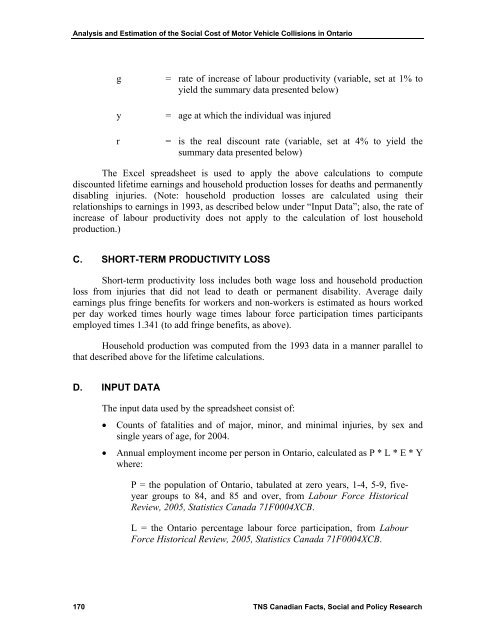Keith Vodden Dr. Douglas Smith - Transports Canada
Keith Vodden Dr. Douglas Smith - Transports Canada
Keith Vodden Dr. Douglas Smith - Transports Canada
You also want an ePaper? Increase the reach of your titles
YUMPU automatically turns print PDFs into web optimized ePapers that Google loves.
Analysis and Estimation of the Social Cost of Motor Vehicle Collisions in Ontario<br />
g<br />
y<br />
r<br />
= rate of increase of labour productivity (variable, set at 1% to<br />
yield the summary data presented below)<br />
= age at which the individual was injured<br />
= is the real discount rate (variable, set at 4% to yield the<br />
summary data presented below)<br />
The Excel spreadsheet is used to apply the above calculations to compute<br />
discounted lifetime earnings and household production losses for deaths and permanently<br />
disabling injuries. (Note: household production losses are calculated using their<br />
relationships to earnings in 1993, as described below under “Input Data”; also, the rate of<br />
increase of labour productivity does not apply to the calculation of lost household<br />
production.)<br />
C. SHORT-TERM PRODUCTIVITY LOSS<br />
Short-term productivity loss includes both wage loss and household production<br />
loss from injuries that did not lead to death or permanent disability. Average daily<br />
earnings plus fringe benefits for workers and non-workers is estimated as hours worked<br />
per day worked times hourly wage times labour force participation times participants<br />
employed times 1.341 (to add fringe benefits, as above).<br />
Household production was computed from the 1993 data in a manner parallel to<br />
that described above for the lifetime calculations.<br />
D. INPUT DATA<br />
The input data used by the spreadsheet consist of:<br />
• Counts of fatalities and of major, minor, and minimal injuries, by sex and<br />
single years of age, for 2004.<br />
• Annual employment income per person in Ontario, calculated as P * L * E * Y<br />
where:<br />
P = the population of Ontario, tabulated at zero years, 1-4, 5-9, fiveyear<br />
groups to 84, and 85 and over, from Labour Force Historical<br />
Review, 2005, Statistics <strong>Canada</strong> 71F0004XCB.<br />
L = the Ontario percentage labour force participation, from Labour<br />
Force Historical Review, 2005, Statistics <strong>Canada</strong> 71F0004XCB.<br />
170 TNS Canadian Facts, Social and Policy Research
















